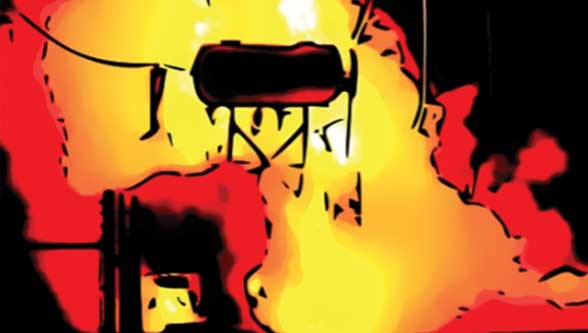By Vishwadeep Nanda, Product Manager- TMI, Rishabh
Insulation testing is very critical type of test for checking the quality of insulation and prevent unwanted breakdowns. Insulation starts to age as soon as it’s made. As it ages, its insulating performance deteriorates. Any harsh installation environments, especially those with temperature extremes and/or chemical contamination, accelerates this process. This deterioration can result in dangerous conditions in power reliability and personnel safety. As such, it’s important to identify this deterioration quickly so that corrective steps can be taken. We will discuss here Basics of insulation, Need of insulation resistance testing, Different test to conduct insulation resistance testing, Recommended test voltages, Methods to know minimum Insulation resistance values of different Device under test (DUTs) and precautions to be taken while Insulation resistance testing.
Let’s start with basics to have a small brush up and establish a better link on subject
What is Insulation?

In simple terms Insulation is nothing but a material which opposes the flow of current. Technically, it contains almost negligible free electrons for the flow of current. There are different types of Insulation material present on Earth which can be classified as Solid (Ceramic, Glass, plastic), Liquid (mineral oil, castor oil) & Gaseous (SF6, Air, etc).
The insulation material is classified according to the temperature’s which they can sustain and not breakdown, take a look in table below as per IEC 60085.
This evokes us with a thought that why do we need insulation? So let’s have a look
The first and basic need of insulation is to provide safety to the human beings and to the circuits in the instruments. In any electrical equipment, the current has to flow along designated conducting pathways (called conductors), Insulation prevents currents from taking other unintended path. Insulation has got the inherent high electrical resistance property which does not allow contact with live circuits and hence ensures safety also Maintain the voltage at the terminals of the load, Avoid arcing to a different voltage or earth, Avoid electrocution. Hence all electrical equipment’s are manufactured by using insulation materials of proper grade in its construction.
So now it’s evident that how important insulation is! Taking this ahead and as we wrote that every electrical/electronic equipment has some kind of insulation over it, leaves us with a question whether insulation degrades and if it degrades, then what will happen if this degradation goes undetected……? let’s discover…
First we will see, why does insulation degrades! we as human beings, as our age increases we get affected with several diseases, our body starts degrading and similar is with insulation. As its continuously exposed to different conditions the degradation in insulation takes place. Let’s see the various reasons of insulation degradation:
Different types of stress lead to degradation in Insulation
There are five types of stresses which leads to degradation in quality of insulation
Electrical stress
- eg: Spikes and over voltages
Mechanical stress
- eg: Vibration, movement, impact
Chemical attack
- eg: Dirt, oil, corrosive vapor
Thermal stress
- eg: Hot/ cold condition, ma chine start/stopping
Environmental conditions
- eg: Moisture, humidity, rodents
As we understood the different reasons of insulation degradation it’s time to now answer what will happen if this degradation of insulation goes undetected?
No! No! don’t worry the intention is not to scare you but just to make you understand what can happen if Insulation resistance testing is not done periodically, all of a sudden you can get horrible surprises like the one in image above.
Let’s have a look at the criticality of Insulation resistance testing how it can be useful at different times of testing!
- As a quality control measure at the time of manufacturing of the electrical equipment, a basic value of insulation resistance is available for reference
- To ensure that the required specified insulation values are met for a new installation
- Periodical preventive maintenance task
- Used as a tool for trouble shootings in the power system /equipment’s
- To avoid unexpected breakdown of the high voltage equipment
- To monitor the rate of change of deterioration of health of insulation
- Saving high cost of replacement of the material
So far we have understood that testing of Insulation resistance periodically is of outmost importance. Now we move on towards the different procedures, methods, various ways that would help us in assessing the quality of insulation.
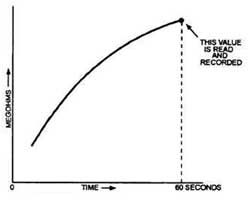
Spot Insulation Test
The most basic test for insulation resistance testing is Spot Insulation test. It suggests the application of test voltage for 1 minute and then note the value of Insulation Resistance. Note when your devices have a very small capacitance then spot test will be all what you need. But mostly equipment’s are capacitive so spot insulation test is an indicator of how good or bad insulation is!
Whenever a Device under Test is subjected to insulation testing and if its highly capacitive in nature then, three types of current flows through the insulation which are:
Capacitive current
The initial burst of current that occurs when voltage is first applied to a conductor is called capacitive current. Like the first rush of water flowing through a hose, it typically starts out high and then drops quickly once the conductor is fully charged.
Absorption current
Like capacitive current, absorption current also starts out high and then drops. However, it falls at a much slower rate. As the voltage builds up, the absorption level in the insulation decreases. This gradual change reflects the storage of potential energy in and along the insulation. Incidentally, absorption current is an important part of the time resistance method of insulation testing.
Leakage current.
Also commonly referred to as conduction current, the small, steady current present both through and over the insulation is called leakage current. Any increase in leakage current over time is usually an indication of deteriorating insulation. This would be noted on the insulation test meter as a decrease in resistance.
As we discussed that most of the devices are capacitive so spot test is just an indicative of good or bad insulation. However, we have further tests which are also called as diagnostic test to have a detail analysis of quality of insulation.
There are different diagnostic tests which can probably be conducted to check the quality of Insulation

1) Polarisation Index test
2) Dielectric Absorption Ratio
3) Step Voltage Test / Ramp test
1) Polarisation Index Test
The PI (Polarisation Index) measures the time required for molecules of insulation to polarize to resist the flow of current. For testing high capacitance systems such as large motors, generators, or apparatus with complex insulation systems. Steady readings are only possible after the time-dependent currents have almost died down.
PI Test measures the ratio between insulation resistance readings taken at one minute and ten minutes after the application of voltage to judge the rate of disappearance of capacitance and absorption currents.
A low polarization index usually indicates excessive moisture and contamination.

2) Dielectric absorption Ratio
Dielectric absorption ratio is the ratio between insulation resistance readings taken at 30 seconds and 1 minute after the application of voltage to judge the rate of disappearance of capacitance and absorption currents.
3) Step Voltage Test / Ramp test
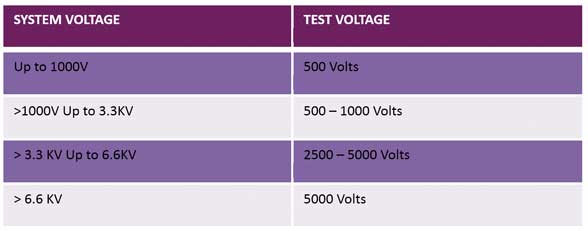
Step voltage test is basically applying the different test voltages in steps for fixed duration of time to check the behavior of Insulation at different test voltages. As per standard generally the variation of insulation resistance between consecutive readings should not be greater than 25% if it is observed beyond 25% then there is some problem with the quality of insulation. Nowadays more popular test is the Ramp test where instead of in discrete steps, voltages are gradually increased and the leakage current is graphed continuously against voltage rise. Normally, the relationship is expected to be linear, but if current begins to rise more sharply, the material is breaking down and the test can be terminated prior to the occurrence of full breakdown. The Ramp Test has been evaluated by standards agencies, and is described in IEEE 95-2002. The evaluation of test results first prescribes that insulation in good condition should produce a smooth, almost linear rising current curve against the applied voltage. Any deviation should be viewed as a warning that the test could be approaching a possible breakdown. A sudden increase in current usually indicates imminent breakdown, and it has been possible to approach as closely as 5% below breakdown voltage.
Thus we have seen different diagnostic test which can be performed to evaluate the quality of installed insulation on any electrical equipment & how these different test methods would be useful to assess the insulation health.
We always have the question in our mind what would be the suitable test voltage to be applied for testing insulation resistance. To answer this question, we have some recommendations published by international testing agencies which we will elaborate so that it would help us to know the different test voltages which would be suitable to test insulation resistance.
Common test voltages depending upon system voltage (L-L)
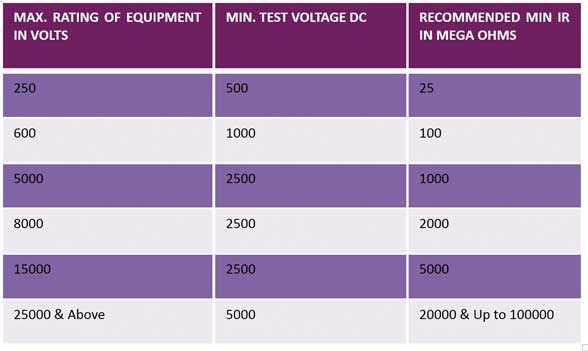
Recommended Values for Good Insulation as per NETA
There are also some of the thumb rules which tell us the minimum required insulation resistance values which are as follows
THE RECOMMENDED MIN IR VALUE (Rm) FOR
Field windings can be determined as
Rm = kV + 1 (M Ohm)
Where,
Rm = Recommended Minimum Insulation in MΏ at 40°C
kV = Rated machine terminal to terminal potential in kV
MIN IR VALUE FOR CABLE AND CONDUCTORS
Single- Conductor Cable
R = K log10 (d/ D)
Where:
R = Mega-ohms per 1000 feet of cable
K = Constant for insulating material
D = Outside diameter of conductor insulation
d = Diameter of conductor
MINIMUM IR VALUES FOR TRANSFORMERS
Recommended minimum insulation resistance for winding to ground with other windings guarded, or from winding to winding with core guarded.
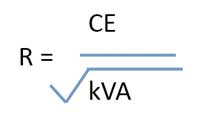
Where:
C = a constant for 20°C
measurements.
E = voltage rating of winding under test.
kVA = rated capacity of winding under test
As we are talking about the insulation resistance testing which is conducted to know the safety level of insulation it’s also very important to know the different safety requirements to be followed while performing the insulation resistance test at different devices under test to ensure the safety of operator. Following are some of the safety requirements
- All equipment under test MUST be disconnected and isolated
- Equipment should be discharged (shunted or shorted out) for at least as long as the test voltage was applied in order to be absolutely safe for the person conducting the test.
- Never use Insulation tester in an explosive atmosphere.
- Make sure all switches are blocked out and cable ends marked properly for safety.
- Cable ends to be isolated shall be disconnected from the supply and protected from contact to supply, or ground, or accidental contact.
- Erection of safety barriers with warning signs, and an open communication channel between testing personnel.
- Do not test when humidity is more than 70 %.
- Good Insulation: IR reading increases first then remain constant.
- Bad Insulation: IR reading increases first and then decreases.
Rishabh offers solutions for testing Insulation resistance through its various products like Rish Insu 10/20 1KV Digital Insulation Tester, Rish MIT 30- Multimeter cum Insulation Tester, Rish Insu 5000 5KV Analog Insulation Tester, Agam AIT 501- 5KV Digital Insulation Tester, Rish Insu 5Dx- 5KV Digital Insulation tester with diagnostic tests like PI, DAR & Ramp test suitable for testing in live switchyards.

For more information
Website: www.rishabh.co.in


